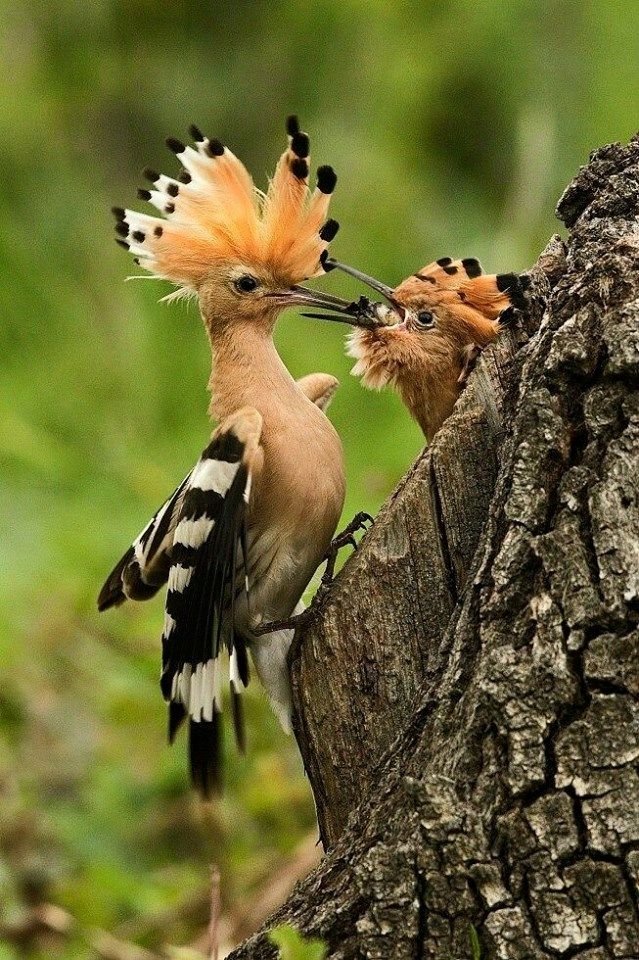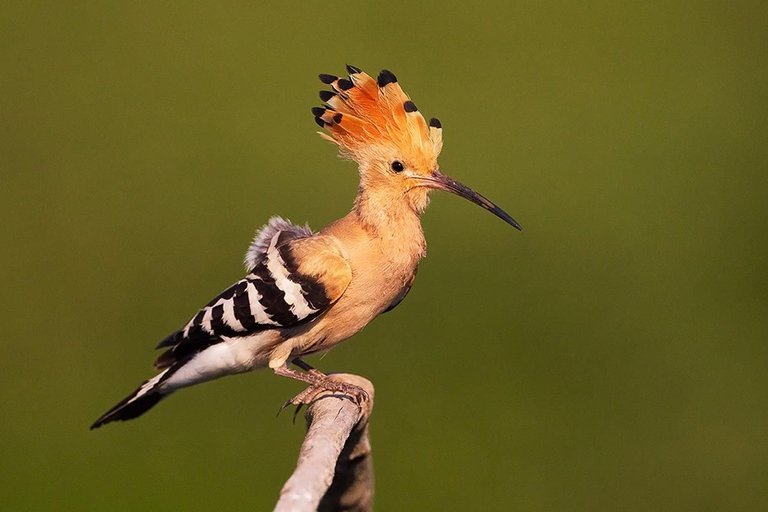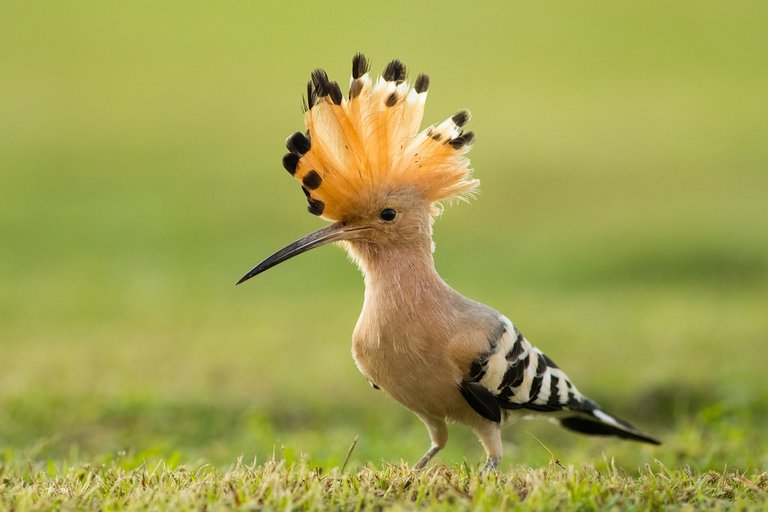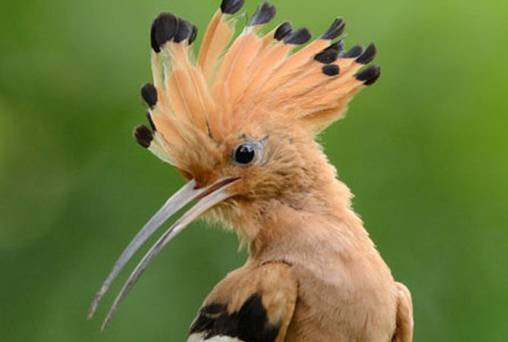Introduction
Famous for its distinctive crown of feathers, Hoopoe bird is found in Afro-Euro Asia. The Latin name for this colorful bird is Upupa while the English name is an onomatopoeic form, which basically imitates the cry or sound which the bird makes. In the family Upupidae, it is the only extant species. The Madagascar subspecies are sometimes referred to or considered as full species. Its subspecies Saint Helena Hoopoe is extinct.

There are nine known subspecies of the Hoopoe as recognized by Kirsten in The Handbook of the Birds of the Worldin the year 2001. These species differ in their size, colors, shades and the plumage. Meanwhile, two more species of Hoopoe have been proposed; one in South Africa and the other in India.
.jpg)
.jpg)
*Hover Effect Hoopoe Physical Features/Appearance
The hoopoe Bird is medium sized. It is 25-32 cm long with a wingspan of around 44-48 cm. The wings are round and broad which ensure a strong flight. In the Northern Migratory species, the wings are larger. The average weight of this bird is 46-89 g depending on the size, gender and the area where it dwells. The Hoopoe has an undulating flight, which appears similar to that of some gigantic butterflies. This is because the wings get half closed after every beat or short sequence of beats.
Their beak is long and strong. This beautiful bird also supports a distinctive bill which is generally black with a fawn base. The rounded muscular curvature of their head also supports the beak by opening up bill, while pecking or digging the soil. The plumage is generally in light shades. However, males have a slightly darker shade than the females. Their call is tri-syllabic oop-oop-oop, while two or four syllables are also common.

*Habitat and Distribution
The Hoopoe is mostly spread across in Europe, Asia and North Africa. It is also widely found in Madagascar and the Sub-Saharan Africa. Most of the birds dwelling in Europe and North Asia migrate to the tropical zones during winters. On the other hand, the bird’s population in Africa is inactive (in terms of migration) all year round.
.jpg)
Their basic requirements for choosing a habitat are:
It should have a little vegetation on the ground on which they can forage.
Some vertical spaces where they can build their nests for example tree, cliffs, walls and haystacks.
These requirements can be met easily by a wide range of ecosystem,
hence the Hoopoes inhabits a wide variety of habitats like:
Heathlands
.Wooded Steppes.
Savannas.
Grasslands.
And Forest Glands.

The changes and alterations made by humans in their natural habitat for the purpose of agriculture and farming has led these birds to also commonly dwell in:
Vineyards.
Orchards.
Olive Groves.
Parkland
and Farmland.
*Diet and Food
The main component of Hoopoes diet is the insects. They mostly feed on insects but some tiny reptiles and frogs are also included in their food diet. They also like to forage on plant matter which includes seeds and berries.
Hover Effect Hoopoe Bird Diet and Food Hover Effect Hoopoe Bird Flying
On rare occasions, they will also feed in air during their flight, as their strong feathers allow them to maneuver around in the air to catch flying insects and moths etc. Their most common style of finding food for themselves is to stride over land and find insects, pupae, insect larvae and crickets, etc. They can probe the soil with their bill and also use their feet to grab insects. The most common prey for Hoopoes are:
Crickets
Locusts
Beetles
Earwigs
Ant Lions
Bugs
Ants
Cicadas
.jpg)
.jpg)
Most of these are around 20-30mm long. For bigger preys that can range between 50-100 mm, Hoopoes prefer to kill them first by thrashing them on the ground or by using stones to beat them.
*Breeding
Hoopoes like to breed in warmer areas. They are monogamous, but the pair lasts just for one season. The female is responsible for incubating eggs and taking care of the nest while the male feeds her and the children during this time.
Interesting Facts about Hoopoe Bird
Some of the interesting facts about Hoopoe are enlisted below:
Hoopoe is the National Bird of Israel.
It enjoys bathing in the sun and dust.
It takes a specific position by spreading its wingsand putting the head down.
Average lifespan of a Hoopoe bird in the wild, its natural habitat, is 10 years.
They can be easily approached while they are eating as they don’t take notice of humans at that time.
Their presence has also be noted on Mt.
Everest at 26,000 ft.It is believed that to hear a Hoopoe singing near a wine press means to foretell a good vintage.
Experienced human nest finders can locate their nests by just sniffing as Hoopoe is known to have poor sanitation in their nest with a lot of foul smell coming from it.
Hover Effect Hoopoe Bird Relationship with Humans
Hoopoe is protected by a lot of societies as it eats the pests and insects that cause damage to forests and the agricultural lands. This bird has a lot of significance apart from saving forests and plantations for humans. Some of the reasons are mentioned as follows:

In Ancient Egypt, they were considered sacred and their pictures were painted on the walls of tombs and temples.
Similarly, they were considered holy and sacred in Minoan Crete.
In Torah, Leviticus 11:13-19, they are mentioned in the list of animals that should be eaten.
They are also listed in Deuteronomy (14:18) asnot Kosher animal.
In Persia, Hoopoe is seen as a symbol of virtue.
In the Persian literature it is mentioned as the leader of the birds.
In the Holy Quran Hoopoes are mentioned as “hudhud” in Surah Al Naml 27: 20-22, in the story of Solomon. In the Islamic Literature it is also mentioned that Hoopoes saved Moses and the children of Israel from being crushed by the giant Og, while crossing the Red Sea.
.jpg)
In some countries and cultures Hoopoes are considered as thieves and a symbol of death and crime. They are also traded for their medicinal benefits. They have also been mentioned in a lot of poems, plays and stories in different times and eras.

Awesome! Used to see these from time to time on my farm in South Africa, truly a beautiful bird. Thanks for bringing back the memory!
Hi! I am a robot. I just upvoted you! I found similar content that readers might be interested in:
http://www.liveanimalslist.com/birds/hoopoe-bird.php
pretty cool post